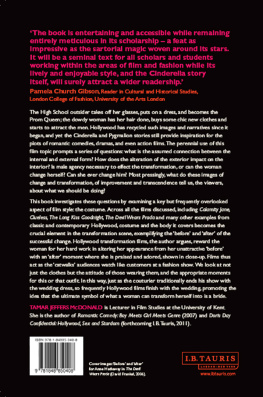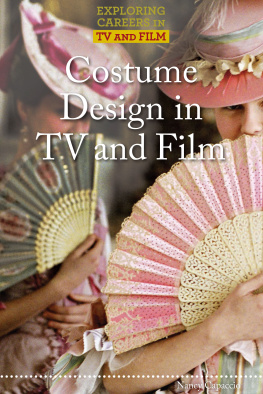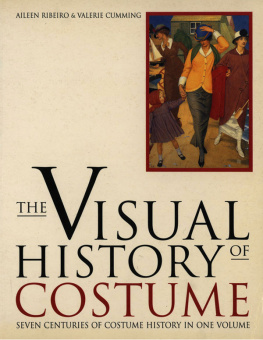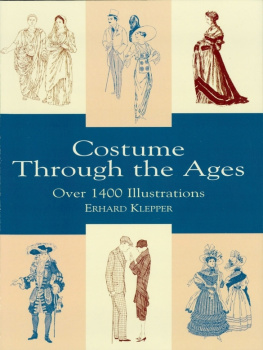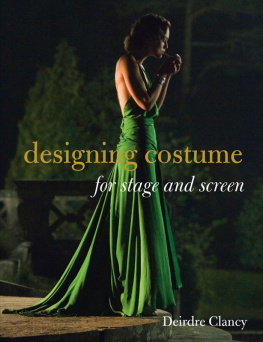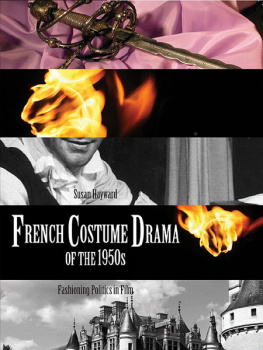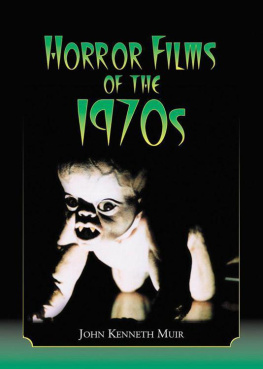TAMAR JEFFERS MCDONALD is Lecturer in Film Studies at the University of Kent. She is the author of Romantic Comedy: Boy Meets Girl Meets Genre (2007) and Doris Day Confidential: Hollywood, Sex and Stardom (forthcoming I.B.Tauris, 2011).
A much-needed addition to the growing body of literature around cinema, costume and consumption, this book adopts a new and radical approach by examining one particular story that of transformation through dress which has formed a staple of cinema since its inception. The author traces the reworkings of the theme from Mlis very first refashioning of the fable to its most recent reincarnation in The Devil Wears Prada. This novel methodology means that the book can examine both the cinematic fortunes of the heroines and the extraordinary changes in the lives of their female audiences.
The book is entertaining and accessible while remaining entirely meticulous in its scholarship a feat as impressive as the sartorial magic woven around its stars. It will be a seminal text for all scholars and students working within the areas of film and fashion while its lively and enjoyable style, and the Cinderella story itself, will surely attract a wider readership.
Pamela Church Gibson, Reader in Cultural and Historical Studies, London College of Fashion, University of the Arts London

Published in 2010 by I.B.Tauris & Co. Ltd
6 Salem Road, London W2 4BU
175 Fifth Avenue, New York NY 10010
www.ibtauris.com
Distributed in the United States and Canada Exclusively by Palgrave Macmillan,
175 Fifth Avenue, New York NY 10010
Copyright Tamar Jeffers McDonald 2010
The right of Tamar Jeffers McDonald to be identified as the author of this work has been asserted by her in accordance with the Copyright, Designs and Patents Act, 1988.
All rights reserved. Except for brief quotations in a review, this book, or any part thereof, may not be reproduced, stored in or introduced into a retrieval system, or transmitted, in any form or by any means, electronic, mechanical, photocopying, recording or otherwise, without the prior written permission of the publisher.
International Library of Cultural Studies: 12
ISBN 978 1 84885 039 2 (HB)
978 1 84885 040 8 (PB)
eISBN 978 0 85773 392 4
A full CIP record for this book is available from the British Library
A full CIP record for this book is available from the
Library of Congress Library of Congress catalog card: available
Typeset in Goudy by Dexter Haven Associates Ltd, London
With love, for Paul the best dressed man I know
contents
Hollywood Catwalk would not be here today without the inspiration, suggestions, support and kindness of so many people. My heartfelt thanks then to you all, but special mention to: Maureen Humphries at the University of Kent for help in sourcing rareties; staff at the British Film Institute, especially Sean Delaney and Anastasia Keremeos, for their unflagging help; Charles Silver at MOMA, New York City, and his projectionist, for screening de Milles unjustly forgotten Forbidden Fruit for me, and the kind members of the SDFVA Research Committee at the University of Kent who gave me a grant enabling me to get there to view it; Tom Bass and Ella Halfacree for DVD sourcing, and Ella for tea and conversational support. For costume and film discussions, thanks must go to my students on the Special Project course at Oxford Brookes University in spring 2007, especially Riccardo Baciagalupo, Maja Bodenstein and Adam Sharpe. Alisia Chase commented on an early draft of the work on The Devil Wears Prada, and suggested the Brenda Weber reading which helped develop it, so many thanks there. Thank you to Richard Dyer, Paul McDonald and Deborah Nadoolman Landis, for inspiring my writing and research in their different, but all inimitably stylish, ways.
In preparing this book I acknowledge the kind support of the Krasna Krausz Foundation for its help with costs associated with photographic reproductions. My admiration and thanks go too to my kind, ever-tolerant and supportive editor at I.B.Tauris, Philippa Brewster, who bore with me while the book I had intended to write transformed itself (appropriately enough) into the one it did.
Finally, of course, I must record sincere and affectionate thanks to my closest support team, Candy, Chlo, Jessica and Paul, for hours of their patience over losing me to the computer, and for again foisting some bizarre films on our family viewing time (Mahogany please forgive me, gang!)
At first glance, La Chrysalide et le Papillon dOr and Date Movie could not be more different. Varying not only in length, sound, colour, 105 years as well as industrial, historical and cultural references also divide them. The former was one of the short films of cinema pioneer Georges Mlis and was shown in France, and then across Europe and America, from 1901, but is only to be found now in film archives or rare collectors box-set DVD. The latter makes up part of a long-standing if loose series of parodic films which began with Scary Movie (2000), and was shown in multiplexes worldwide before transferring to home viewing on DVD. Yet despite their many differences, one key facet remains the same: the transformation story. Forming the central episode of the Mlis short and an early and key sequence in Date Movie (2006), the transformation scene links these two films across and despite the other chronological and cultural gaps which separate them.
A man transforms a caterpillar into a beautiful butterfly woman; a team of men work over a fat woman, whittling a slender-limbed individual from the giant bulk. Although separated by over a century, the two filmic scenes maintain the same basic premise: through male agency, an ugly or undesirable creature is turned into a beautiful woman. While La Chrysalide evokes Ali Baba and Mozarts The Magic Flute in its mise-en-scene, and Date Movie draws on MTV show Pimp My Ride, both scenes demonstrate how physical and sartorial transformation can change the appearance and the fortune of the unattractive original.
As film historians have noted (Kovacs, 1976; Bloom, 2000; Ezra, 2000; 2006), Mlis was a keen magician and developed his interest in film as an adjunct to the theatrical performance of magic tricks. La Chrysalide is similar to other short films in the film-makers catalogue in referencing this interest in magic, and also makes use of feminine allure and the exotic. In La Chrysalide this fascination with magic is evident in the stage business performed by the central male figure, played by Mlis himself. The scene, a woodland clearing or jungle glade, is established by the creation of backdrops painted with exotic plants and flowers and arranged direct to camera, as were so many of Mlis films (Kovacs: 7), so that the viewer is positioned like a member of a theatre audience, looking towards the stage framed by a proscenium arch. Mlis, attired in what would appear to be an attempt at Arabian robes (stripy turban, stripy robe, pantaloons and tights) emerges and produces a large white egg-shaped pod, the chrysalis of the title.
Tilting it towards the audience to prove that it is currently empty just as a magician displays an empty top hat before conjuring the rabbit Mlis then fixes the pod so that it hangs in the very centre of the stage. The magician discovers a flute and begins to mime playing it vigorously. A giant stripy caterpillar emerges from stage left and, evidently entranced by the music, makes its slow way over to the player, before rearing its head up slightly, presumably to speak into the magicians ear. Having heard the caterpillar, the magician kisses it benevolently, picks it up and places it in the pod. After a magicianly pass over the chrysalis to work his magic, the conjuror reveals the transformation: a beautiful butterfly woman emerges, revealing her glorious wings and balancing for a moment with her foot on the mans hand. The butterfly then comes down to the stage and dances about. Appearing enamoured of the butterfly lady, the magician tries to catch her with a blanket. Eventually he manages to throw this over her head and it subdues the woman instantly. Two Arabian handmaidens (attired in necklaces and harem pants) enter from stage left and remove the blanket, revealing the second transformation: the butterfly woman has gone, replaced by an Arabian princess. The magician appears even more enraptured by the sight of this version of the woman and, pleading for her love, sinks to one knee before her. She however rejects his love by turning her back on him; he grabs at her veil and she angrily turns, puts her foot on his head and changes him into a caterpillar! Having trumped his magic with her own, she then walks off stage right, followed by the two handmaidens. The stripy caterpillar remains centre stage as the film fades to black.
Next page
